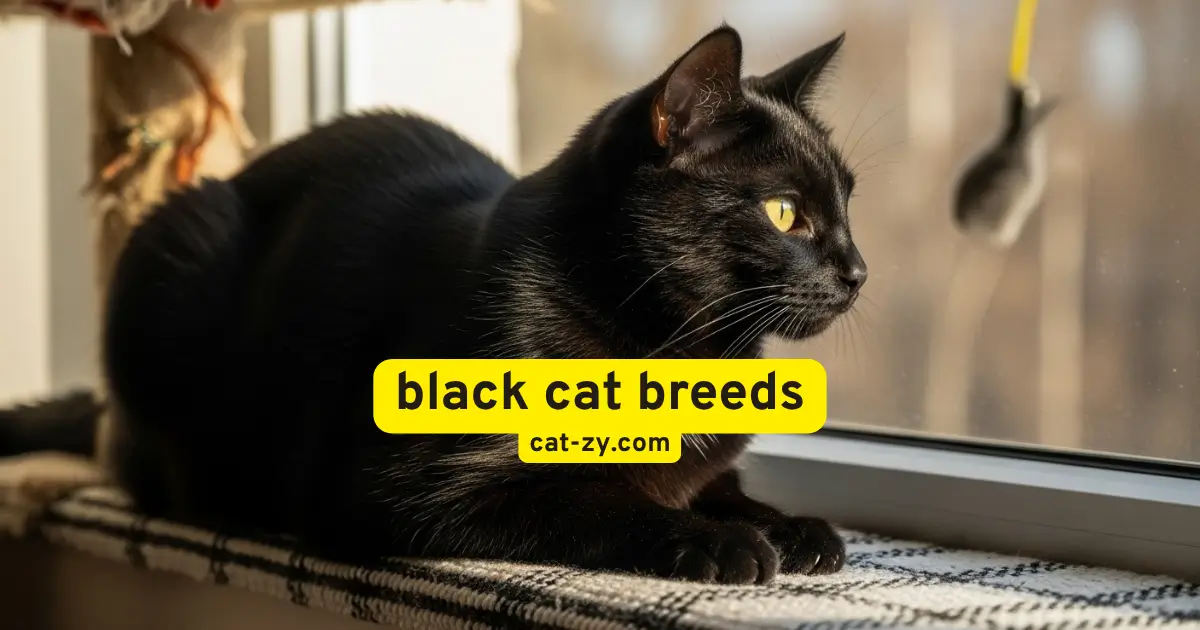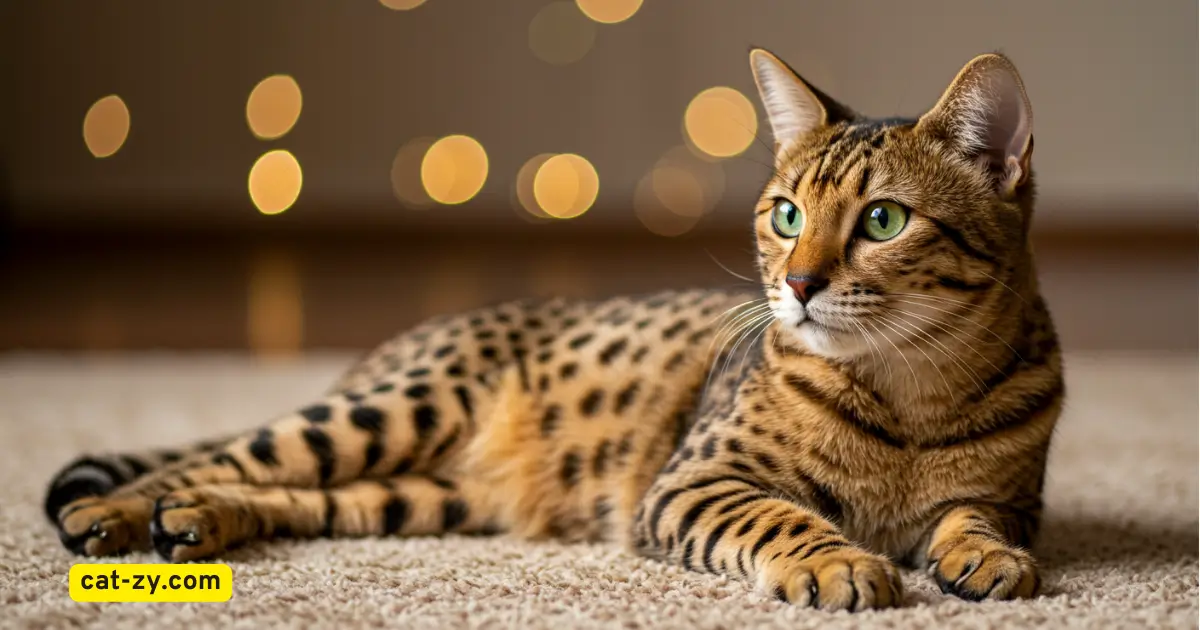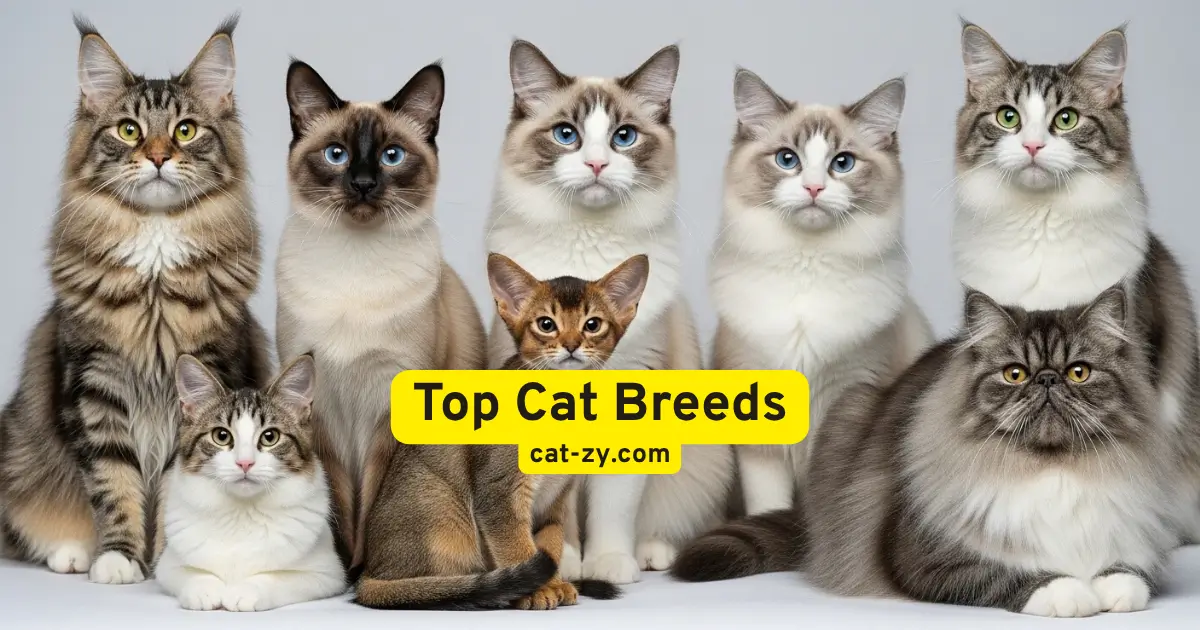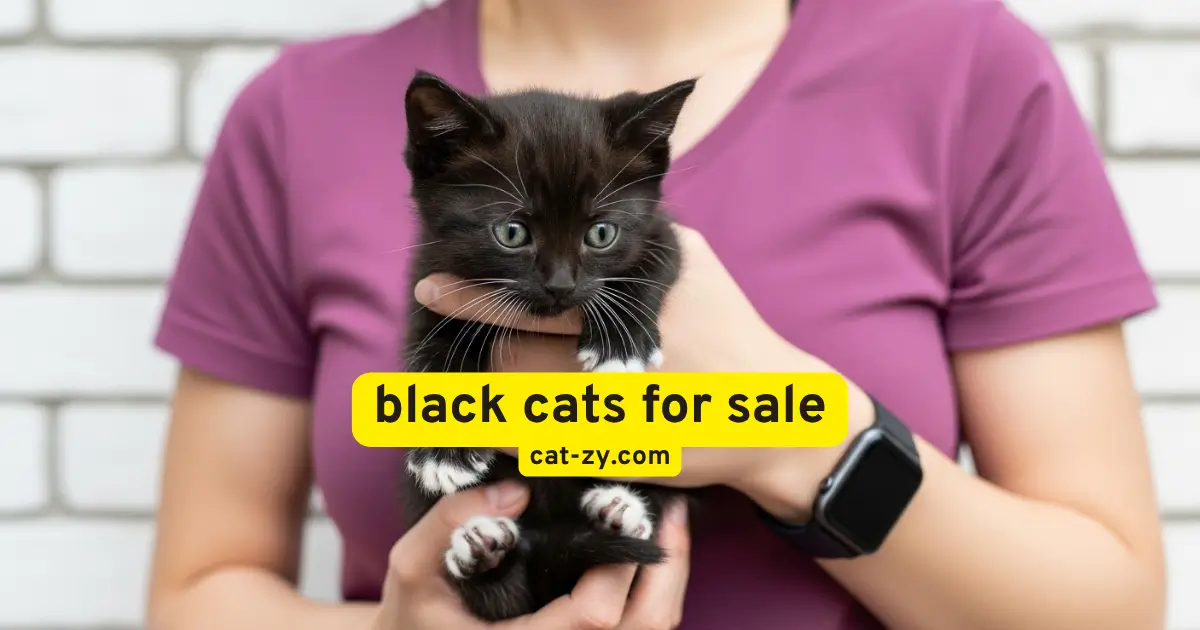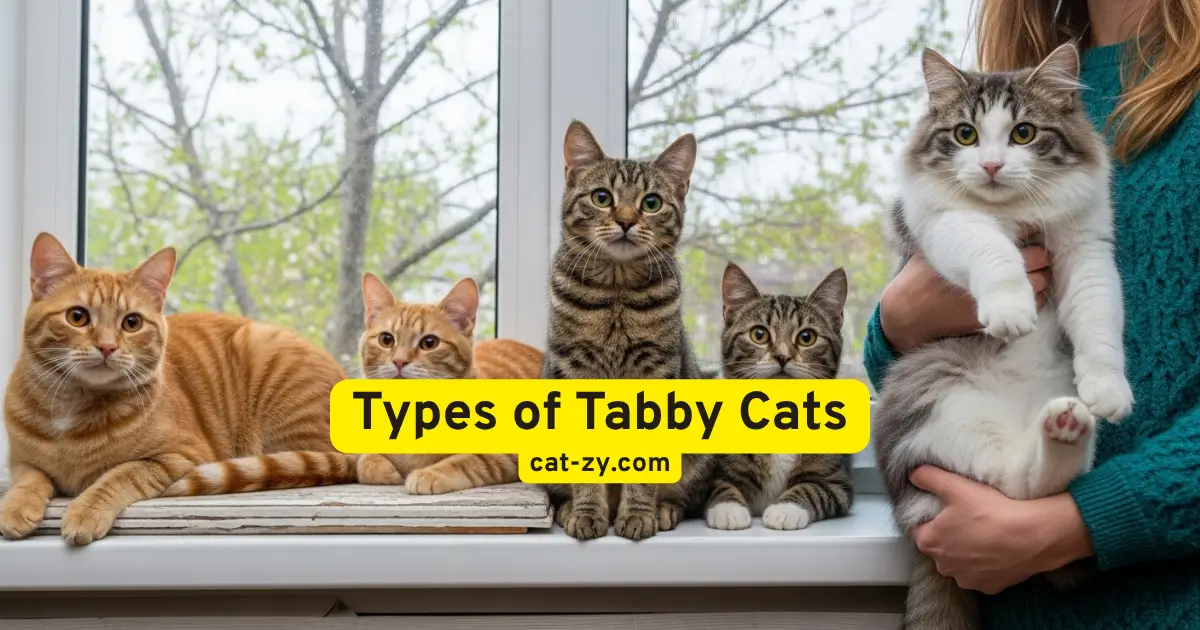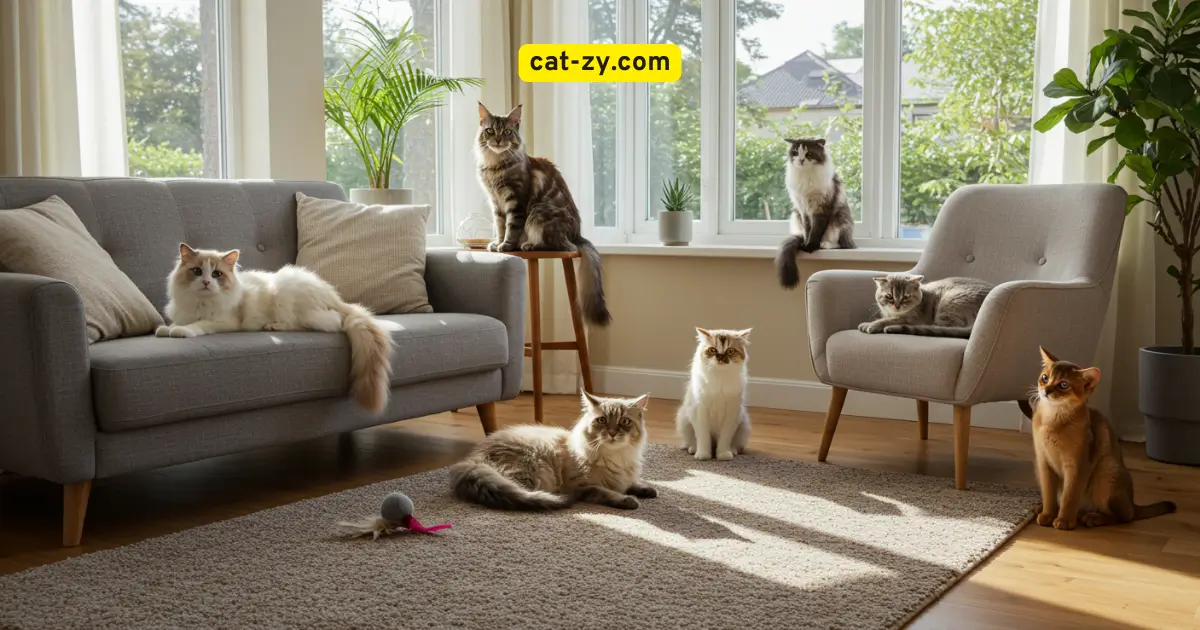Black Cat Breeds: 9 Mysterious Beauties You’ll Adore
Are you drawn to the mystique of mysterious felines? If so, you’re not alone. For centuries, black cats have captivated hearts with their sleek coats and enigmatic presence.
There’s something undeniably alluring about these creatures. It’s not just their striking appearance. Whether you’re a seasoned cat owner or just an admirer, the world of black cat breeds is full of fascinating stories and characteristics waiting to be discovered.
In this article, we’ll explore nine stunning breeds that embody the beauty and intrigue associated with these mysterious animals. From their unique histories to their captivating personalities, you’ll gain a deeper understanding of what makes these felines so beloved.
Table of Contents
The Mystique of Black Cats Throughout History
Black cats have always fascinated people, bringing both wonder and fear. They have been a part of many cultures, carrying deep meanings and spiritual values.
Cultural Significance and Superstitions
Throughout history, black cats have served as central characters in countless tales and legends. In old times, they were seen as having magical powers.
Ancient Egyptian Reverence
In Ancient Egypt, black cats were linked to the goddess Bastet. They stood for protection and fertility. People would mummify and bury them with their loved ones to help them on their journey to the afterlife.
Medieval European Fears
But in the Medieval period in Europe, things changed. During medieval times, black cats were thought to be companions of witches, resulting in widespread superstition and mistreatment.
Debunking Black Cat Myths
Numerous misconceptions surrounding black cats have been debunked by modern understanding. Now, people see them as beautiful and charming.
Modern Perceptions
In contemporary times, black cats are cherished for their elegant demeanor and enigmatic charm. Many breeds are recognized for their distinctive appearances.
Black Cat Appreciation Day
Black Cat Appreciation Day is on August 17th. It’s a time to celebrate black cats’ beauty and encourage people to adopt them. This celebration highlights the beauty of Black Cat Breeds worldwide.
Black Cat Breeds: Popular Varieties and Their Unique Genetics
Beyond their stunning appearance, black cats possess intriguing genetic characteristics. For centuries, humans have been drawn to their sleek coats and mysterious appeal.
The Science Behind Black Fur
A feline’s coat color results from the synthesis of melanin pigments. Melanin production is how cells make pigment, leading to black fur.
Melanin Production
Melanin is made by cells called melanocytes. The type and amount of melanin decide the cat’s fur color.
Genetic Factors
Genetics play a big role in melanin production. This affects the cat’s fur color.
Common Traits Among Black Cats
While black cats might exhibit similar characteristics, every individual is distinct. Proper health monitoring and grooming practices are essential for their well-being.
Health Considerations
Typically, black cats maintain the same health standards as felines of other colors. But some breeds might face specific health issues.
Coat Maintenance
Keeping a black cat’s coat clean is important. Regular grooming prevents mats and keeps their fur shiny.
Learning about black cat genetics and traits can make you appreciate them more.
Bombay: The Mini Panther
Among Black Cat Breeds, the Bombay cat is a unique feline, resembling a miniature black panther. It has a striking appearance and a charming personality. This makes it a favorite among cat lovers.
Physical Characteristics
The Bombay cat has a sleek and glossy coat that’s usually black. This gives it a panther-like look.
Sleek Coat and Build
Its coat is short, fine, and close to the skin, needing little grooming. The Bombay’s muscular and athletic build adds to its sleek look.
Distinctive Features
A distinctive characteristic includes their amber or bronze-colored eyes. These eyes stand out against its black coat.
Personality and Temperament
Bombay cats are affectionate and playful. These cats thrive on human companionship and delight in interactive activities.
Social Behavior
Their behavior resembles that of canines, trailing their humans and engaging in retrieval games. This makes them very social.
Family Compatibility
Bombay cats get along well with families that have older kids or other pets. They are gentle and easy-going.
Care Requirements
To keep your Bombay cat healthy, it needs the right food and exercise.
Diet and Exercise
They need a balanced diet and regular play. This keeps their muscles strong and their health good.
Grooming Needs
Their short coat needs little grooming. This makes them easy to care for.
Origin and History
The Bombay breed was created in the 1950s. The breed originated from crossbreeding Burmese cats with American Shorthair lines.
Development of the Breed
The breeding objective was to develop a feline resembling a miniature ebony panther. The breed was recognized in the 1970s.
Notable Milestones
Over time, the breed became popular. This is because of its unique look and friendly nature.
American Shorthair: The Classic Black Beauty
The American Shorthair is a standout among black cat breeds. It’s known for its classic looks and strong body. This breed has been a favorite in American homes for many years.
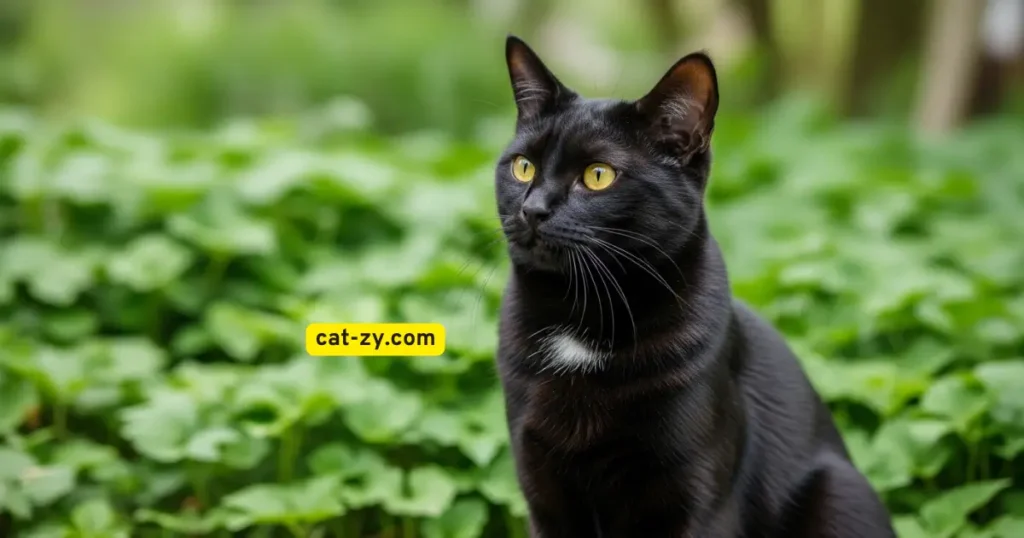
Physical Characteristics
The American Shorthair has a sturdy build and a unique look. Its physical traits include:
Body Structure
This member of the Black Cat Breeds has a broad chest and strong muscles. These features show its origins as a working cat.
Coat Quality
The American Shorthair’s coat is short, dense, and comes in many colors, including black. It needs little grooming, making it easy for owners to care for.
Personality and Temperament
The American Shorthair is known for being easy-going and adaptable. Its key traits are:
Adaptability
This member of the Black Cat Breeds fits well in various living situations, from apartments to homes with yards.
Interaction with Other Pets
American Shorthairs are friendly and can get along with other pets. They do best if socialized early.
Care Requirements
To keep your American Shorthair healthy and happy, follow these care tips:
Health Monitoring
Regular vet visits are key to catching any health problems early, like hypertrophic cardiomyopathy.
Exercise Needs
American Shorthairs need regular play to stay physically and mentally healthy.
Origin and History
The American Shorthair has a rich history that shows its American roots and evolution.
American Heritage
It was brought to North America by European settlers. Over time, it became a distinct and strong feline companion.
Breed Evolution
Through selective breeding, the American Shorthair evolved into the diverse and resilient breed we know today. The breed’s defining characteristics include a compact coat and wide facial structure.
Oriental Shorthair: The Elegant Shadow
The Oriental Shorthair is elegant, playful, and loving. As one of the most elegant Black Cat Breeds, they have short, shiny coats.
Physical Characteristics
Oriental Shorthair cats possess a lean physique paired with a uniquely sculpted cranium. These features make them look elegant.
Slender Frame
They have a muscular yet sleek body. This design makes them agile and graceful.
Distinctive Head Shape
Their triangular skull structure, prominent ears, and captivating gaze define their appearance. Their face is unique and captivating.
Personality and Temperament
This breed is renowned for its communicative tendencies and exceptional cognitive abilities. They make great companions.
Vocal Nature
These cats express themselves freely, frequently engaging in vocal conversations with their humans.
Intelligence Level
They are curious and playful. They need toys and interaction to stay stimulated.
Care Requirements
To keep your Oriental Shorthair happy and healthy, consider their environmental needs and preventative health care.
Environmental Needs
Give them a stimulating environment with toys and climbing structures. This keeps them active.
Preventative Health Care
Regular vet visits are key to their health. They help catch any issues early.
Origin and History
The Oriental Shorthair has a Siamese connection. Its breed recognition has evolved over time.
Siamese Connection
They were bred from the Siamese. They now have a wider range of coat colors and patterns.
Breed Recognition
Major cat registries have recognized the breed. This has solidified its popularity.
Maine Coon: The Gentle Black Giant
Among Black Cat Breeds, if you’re looking for a large, affectionate companion, the Maine Coon is perfect. They are known for their massive size and friendly nature. This makes them a favorite among cat lovers.
Physical Characteristics
The Maine Coon’s physical traits are truly striking. They are known for their large size and unique coat patterns.
Size and Weight
Maine Coon cats are among the largest domesticated breeds. Adult males may reach weights of 25 pounds, while females typically max out at 19 pounds. Their muscular build adds to their sturdy look.
Distinctive Tufts and Tail
One of the Maine Coon’s standout features is its tufted ears and bushy tail. These add to their rugged look, showing their origins as working cats.
Personality and Temperament
Maine Coon cats are celebrated for their tender, loving temperament. They are often called “dog-like” because they love to follow their owners and play fetch.
Gentle Giant Behavior
Despite their size, Maine Coons are gentle giants. They are laid-back and easy-going, making them great for families with kids.
Child-Friendly Nature
Maine Coons are excellent for families. They are patient and playful, tolerating children’s noise and activity well.
Care Requirements
Maintaining your Maine Coon’s wellness requires consistent brushing routines and nutritionally complete meals.
Long Coat Maintenance
Maine Coons have a thick, water-resistant coat. Regular brushing prevents matting and keeps their coat in good shape.
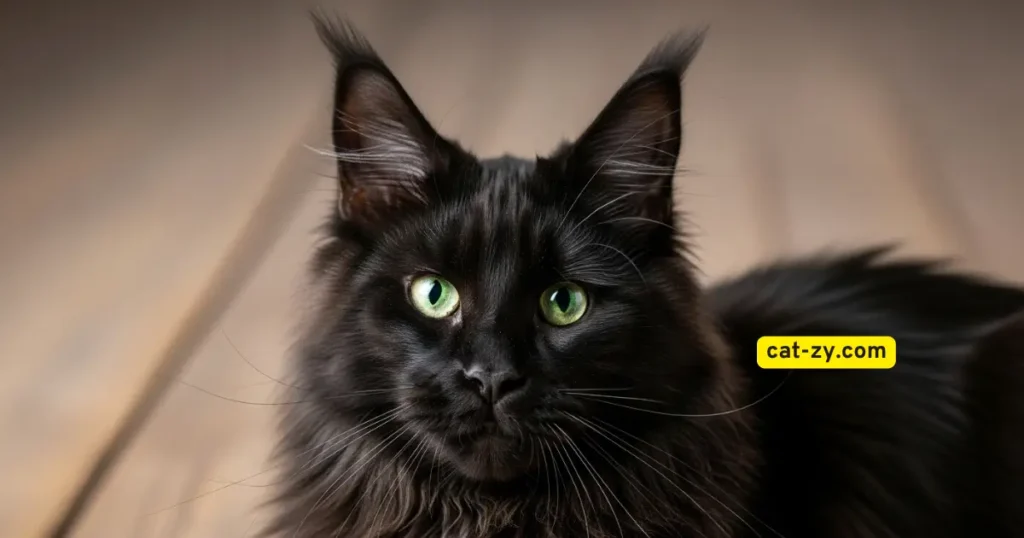
Nutritional Needs
A balanced diet rich in protein is vital for a Maine Coon’s health. Select premium feline nutrition that satisfies their dietary requirements.
Origin and History
The Maine Coon has a rich history, originating in North America. They were valued for their hunting skills and rugged look.
Native American Legends
There are many legends about the Maine Coon’s origins, including their connection to Native American tribes. These stories add to their mystique.
Modern Popularity
Currently, Maine Coon cats enjoy global popularity and admiration. They are cherished for their intelligence, loyalty, and striking appearance.
British Shorthair: The Plush Midnight Companion
The British Shorthair ranks among the most beloved Black Cat Breeds. These cats feature a robust physique complemented by plush fur. Their broad faces and short coats add to their rugged charm.
Physical Characteristics
The British Shorthair stands out with its sturdy build and broad face.
Round Face and Cheeks
They have a round face and chubby cheeks. This makes them irresistibly cute.
Dense Coat Texture
Their coat is soft and dense. It’s a joy to touch.
Personality and Temperament
British Shorthairs are calm and loving. They like to be around people but don’t always ask for attention.
Reserved Demeanor
They can be shy at first. It takes time for them to open up to new people and places.
Independence Level
Even though they love people, they also enjoy being alone. They can keep themselves busy for a while.
Care Requirements
Keeping your British Shorthair happy and healthy requires regular care. This includes watching their weight and grooming them often.
Weight Management
They can easily get overweight. So, it’s important to feed them right and make sure they exercise.
Grooming Schedule
Their thick coat needs regular grooming. This prevents mats and keeps it looking great.
Origin and History
British Shorthair cats trace their lineage to classic British household felines.
British Heritage
They have a long history in the UK. Official breed recognition was established during the final decades of the 1800s.
Breed Standardization
Efforts to standardize the breed helped it get recognized by major cat registries. This solidified its place in cat breeding.
Sphynx: The Hairless Ebony Wonder
The Sphynx black cat is known for its charm and elegance. They have sleek, wrinkled skin that needs special care. Despite no fur, they are healthy and very affectionate.
Physical Characteristics
The Sphynx breed is famous for being hairless. This is due to a natural genetic mutation. Their skin is smooth and wrinkled, feeling like suede.
Skin Pigmentation
Sphynx cats have skin in many colors, including black. This color comes from their skin’s pigmentation.
Body Temperature Regulation
Without fur, Sphynx cats need a warm place to live. They struggle to keep their body temperature up.
Personality and Temperament
Sphynx cats are energetic and playful. These cats crave human interaction and display tremendous warmth toward their families.
Energetic Nature
These cats are always active. Abundant recreational activities are essential for their emotional and physical well-being.
Attention-Seeking Behavior
Sphynx cats love attention. They seek out human interaction, making them perfect for those who enjoy interactive pets.
Care Requirements
Looking after a Sphynx cat means regular skin care and keeping them warm.
Skin Care Routine
They need to be bathed often to remove oils. Regular grooming is also key to preventing oil buildup.
Temperature Sensitivity
Due to their hairless nature, Sphynx cats experience heightened vulnerability to low temperatures. They need a warm, draft-free home.
Origin and History
The Sphynx breed came from a natural genetic mutation that made them hairless.
Genetic Mutation
The initial hairless feline was discovered in Canada during the 1960s, sparking a selective breeding initiative that established the Sphynx breed.
Breed Development
Through careful breeding, the Sphynx became a recognized breed. These cats are recognized for their distinctive appearance and devoted personality.
Devon Rex: The Pixie-Like Dark Elf
The Devon Rex stands out in the world of black cat breeds. It has unique wavy fur and a playful nature. This makes it a favorite pet for many.
Physical Characteristics
The Devon Rex has special features. Its wavy coat pattern is one of them.
Wavy Coat Pattern
Its coat is soft and curly. It needs little grooming but looks great.
Large Ears and Eyes
They also have large ears and big eyes. These features make them look like elves, which is very charming.
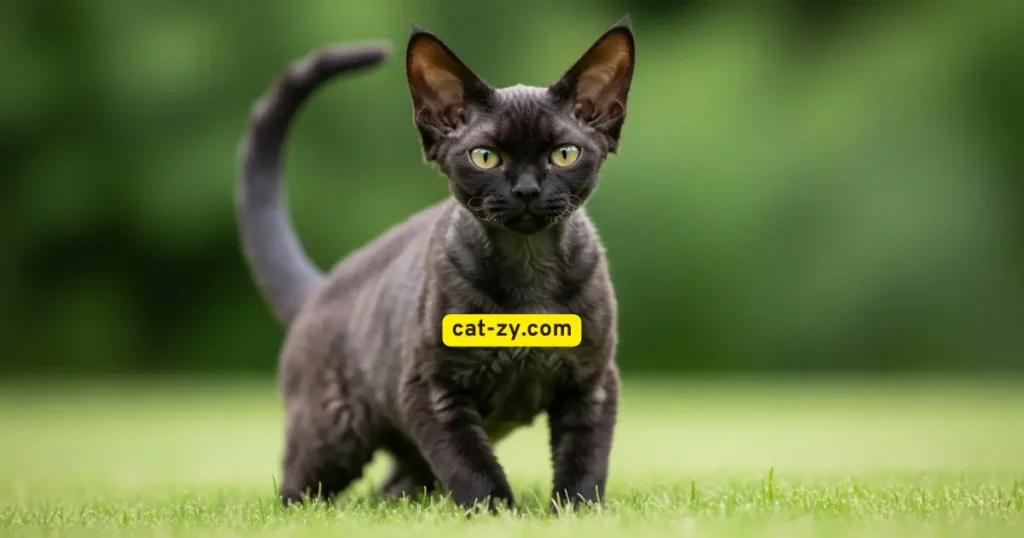
Personality and Temperament
Devon Rex cats are full of playful antics. They are always curious and fun to watch.
Playful Antics
They love to play and are very energetic. They enjoy chasing toys and climbing.
Social Requirements
These cats need lots of social interaction. They do best with owners who spend time with them.
Care Requirements
Even though their coat is low-maintenance, they need special care. They need regular ear cleaning because of their big ears.
Ear Cleaning
Cleaning their ears is crucial. It helps prevent wax buildup and infections.
Minimal Grooming
But their coat is easy to groom. This is great for people who are busy.
Origin and History
The Devon Rex came from England. It was first found in the 1950s.
Discovery in England
This member of the Black Cat Breeds started with a natural mutation in a feral cat. It was then bred with other cats to create the Devon Rex we know today.
Breed Recognition Journey
Following its discovery, official feline organizations granted the breed formal recognition. It became a recognized breed over time.
Japanese Bobtail: The Lucky Black Charm
Japanese Bobtail cats are magnificent felines distinguished by their shortened tails and ebony coats. It has won many hearts with its looks and personality. As a black cat breed, it stands out for its unique traits and cultural importance.
Physical Characteristics
The Japanese Bobtail has several unique features. The breed’s signature feature is its truncated tail, which results from a spontaneous genetic variation. This tail comes in different lengths and shapes, adding to its charm.
Distinctive Bobbed Tail
The bobbed tail is not just pretty; it’s a breed-defining feature. The tail’s length and flexibility vary, but it always looks like a ‘pumpkin’ at the base.
Muscular Build
Under their sleek coats, Japanese Bobtails are muscular. This makes them agile and active. Their strength and smarts make them great companions.
Personality and Temperament
Japanese Bobtails are intelligent and active. They love to play and interact, making them perfect for active owners.
Active Lifestyle
These cats need lots of activity to thrive. They’re great for owners who play a lot with their pets. They’re also very affectionate.
Intelligent Behavior
They’re curious and can solve problems. Japanese Bobtails are playful and can learn tricks or play with puzzle toys.
Care Requirements
To keep a Japanese Bobtail happy and healthy, regular play and mental stimulation are key. They have a short coat that needs little grooming, but their health should be checked often.
Interactive Play
Playing with feather toys, laser pointers, or games is important. This keeps them physically and mentally healthy. They love to join in family activities.
Health Monitoring
While Japanese Bobtail cats typically enjoy good health, they may encounter certain medical conditions. Regular vet visits are crucial to keep them well and catch any problems early.
Origin and History
The Japanese Bobtail has a rich history in Japanese culture. Its unique look and charming personality have made it a favorite worldwide.
Japanese Cultural Significance
In Japan, the Bobtail is seen as lucky. Their role in Japanese folklore and art shows their cultural importance and special place in Japanese hearts.
Introduction to the Western World
Western countries became acquainted with this breed during the 1900s. It quickly became popular for its unique look and engaging personality. Today, it’s loved by cat lovers globally.
Caring for Your Black Cat: Special Considerations
Being a black cat owner comes with its own set of joys and challenges. Understanding their unique needs is key to a fulfilling relationship. It’s also important to show off their beauty.
Photography Tips for Black Cats
Photographing your black cat can be a fun and rewarding hobby. Here are some tips to help you get the best shots.
Lighting Techniques
When taking photos of black cats, lighting is crucial. Natural light is best, but indoor shots can benefit from softbox lights or diffused flash. This helps avoid harsh shadows.
Best Camera Settings
Select photographic equipment that excels in dimly lit conditions. Set your camera to a low ISO and a wide aperture. This will create a beautiful bokeh effect that makes your cat stand out.
Addressing Adoption Challenges
Black cats often face challenges in shelters due to superstitions and misconceptions. Knowing about these issues can help make a difference.
Black Cat Syndrome
Black Cat Syndrome describes the phenomenon where dark-coated felines are frequently passed over in rescue facilities. Raising awareness can help increase their adoption rates.
Adoption Resources
If you’re thinking about adopting a black cat, look for local shelters or rescue groups. They offer resources and support. Digital platforms also feature black cats seeking permanent loving families.
Conclusion: Embracing the Beauty of Black Cat Breeds
Exploring black cat breeds has shown you nine unique felines. From the sleek Bombay to the majestic Maine Coon, each has its charm. Their mysterious history, striking looks, and loving nature have won many hearts.
Learning about their care is key to their happiness. With the right care, black cats can be wonderful companions. Remember, each of these Black Cat Breeds is special and can bring joy to your home. Their beauty is not just in their coats but also in their loving and playful nature.
FAQ
What are some popular black cat breeds?
Popular black cat breeds include the Bombay, American Shorthair, and Oriental Shorthair. Also, the Maine Coon, British Shorthair, Sphynx, Devon Rex, and Japanese Bobtail are favorites.
Are black cats more prone to health issues?
Being black doesn’t mean a cat is more likely to get sick. Regular vet visits and a healthy lifestyle can prevent or manage health problems.
What are the proper grooming techniques for maintaining a black cat’s fur?
To care for a black cat’s coat, brush them regularly to avoid mats. Bathe them sometimes to keep their coat shiny. How often you groom depends on the cat and their breed.
Can black cats be adopted from shelters?
Indeed, numerous black cats currently reside in rescue facilities awaiting adoption. They face challenges due to superstitions, known as Black Cat Syndrome. Adopting one can be very rewarding.
How can I capture great photos of my black cat?
For great photos, use natural light or a well-lit studio. Adjust your camera settings for their dark coat. Try different angles and backgrounds for the best shots.
Are black cats intelligent?
Yes, black cats are as smart as cats of any color. Intelligence varies among cats, not by coat color. Keep their minds active with play and mental stimulation.
Do black cats have a specific personality?
While personalities differ, some black cats are friendly or playful. Knowing your cat’s breed and personality helps meet their needs and understand their behavior.
What breeds are black cats?
Black cats can be found in many different breeds, including purebreds and mixed breeds. The most common Black Cat Breeds are Bombay, American Shorthair, Oriental Shorthair, Maine Coon, British Shorthair, Sphynx, Devon Rex, and Japanese Bobtail. Many domestic shorthair and longhair cats also come in solid black coats.

